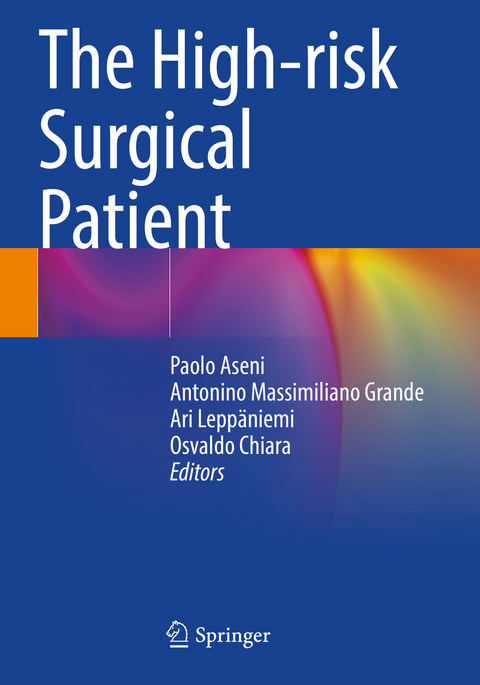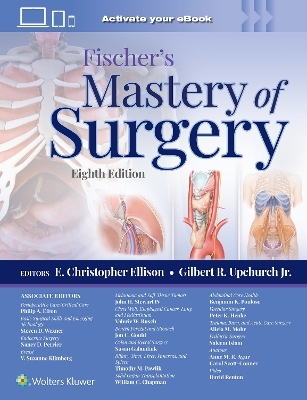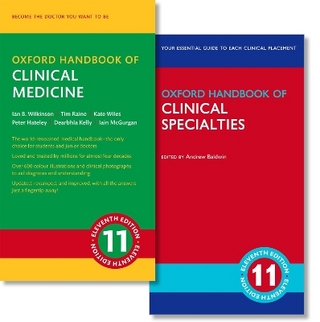
The High-risk Surgical Patient
Springer International Publishing
978-3-031-17275-5 (ISBN)
It is well known that certain diseases and patient conditions are associated with increased perioperative risk. The aim of this book is to define and identify the clinical factors that warrant a broader and more detailed assessment of pre-operative surgical risk in difficult and unusual clinical settings. One of the sections is dedicated to the main pathway of peri- and post-surgical critical care based on the patient-specific deterioration risk and associated diseases; here, a panel of selected experts describes the correct patient-oriented pathways for complex or unscheduled surgical operations in order to reduce the operative risk. In addition, the book describes the latest trends in minimally invasive surgical techniques that are associated with peri- and post-operative risk reduction, and provides an overview of recent advances in surgical simulation, focusing on perspectives in surgical research to increase patient safety.
Guidance is also provided on extracorporeal membrane oxygenation (ECMO), Left Ventricular Assist Devices (LVADs), and their management in patients requiring emergency surgery.
The book will help surgical trainees recognize cases with the highest surgical risk and identify the most common complications at an early stage.
Paolo Aseni works at the Department of Emergency at the Niguarda Hospital in Milan, Italy. He worked in the General Surgical Department and Abdominal Transplant Center of the same Hospital, where he was mainly involved in abdominal organ transplantation, abdominal surgery and emergency surgery. At the same hospital, he is currently responsible for basic surgical training for the emergency medical team. At the University of Medicine of Milan, he holds the position of Assistant Professor of Anatomy and Human Macroscopic Morphology.
Antonino M. Grande is an attending surgeon in Cardiac Surgery - Heart and Lung Transplant Department at the IRCCS Fondazione Policlinico San Matteo in Pavia. His clinical interests include heart failure, heart/lung transplants and mechanical circulatory support. He did a Fellowship in Cardiovascular Surgery at the Texas Heart Institute in Houston, Texas, U.S.A., and he was an Assistant Professor of Surgical Anatomy at the University of Pavia, Italy.
Ari Leppaniemi is the Chief of Emergency Surgery and Surgical Critical Care at the Helsinki University Hospital Meilahti, Finland. His research interests include abdominal trauma, peritonitis, pancreatitis, abdominal compartment syndrome, open abdomen, and complex reoperative and abdominal wall surgery. He is an honorary fellow of the ACS, President of the Finnish Society of Surgery and President of the European Society for Trauma and Emergency Surgery.
Osvaldo Chiara has been an American College of Surgeons ATLS instructor and Director of American College of Surgeons ATOM courses in Europe. He was also a Visiting Professor at the Shock Trauma Center, State University of Maryland, Baltimore, USA. His research interests include shock, trauma surgery, open abdomen, and non-operative management in trauma. He is Director of the Trauma Team and Scientific Coordinator of the Trauma Center at the Niguarda General Hospital in Milan, and a Full Professor of Emergency and Trauma Surgery at the State University of Milan.
Defining the high-risk surgical patient.- The frail patient in the operating room: practical steps to reduce the operative risk.- The high risk surgical patients: the pathophysiologic perspective.- Monitoring and interpretation of vital signs in the high risk surgical patients.- Evaluation and critical care management of the burn patients.- Acid-base abnormalities in surgical patients admitted to intensive care unit.- Pre-operative cardiovascular risk assessment in non-cardiac general surgery.- Post-operative liver failure and pre-operative evaluation of the risk of surgery in patients with liver disease.- Radiology for surgeons: improving the diagnostic accuracy in the high risk surgical patient.- Oncologic emergencies in patients undergoing major surgery.- The paediatric high risk surgical patients.- Difficult intubation in high-risk surgical patients.- Recognition and early management of sepsis in frail patients.- Preoperative evaluation for complex pulmonary surgery: how can we balance the risk?.- Assessment of pre-operative risk in complex cardiac surgery.- Patient safety in surgery: strategies to achieve the best outcomes in high-risk surgical patients.- Strategies to reduce the risk of post-operative pulmonary complications.- Prevention and management of perioperative neurological complications in high-risk surgical patients.- Acute aortic syndrome: a high-risk missed diagnosis in ED.- Percutaneous Interventional Treatment of Structural Heart Diseases (Non-coronary).- New technologies in urologic surgery: Robotic and minimally invasive procedures.- New Trends in vascular surgery: less open and more endovascular procedures.- New trends in laparoscopic procedures in the emergency abdominal surgery.- New trends in the treatment of severe acute pancreatitis.- Point of Care US in the preoperative evaluation of the high-risk surgical patient requiring urgent non-cardiac surgery.- Perioperative monitoring in the high-risk surgical patients: a step-by-step approach.- High-risk pancreatic anastomosis: Prediction, mitigation, and management of postoperative pancreatic fistula?.- Anaesthesia in high-risk surgical patients with uncommon diseases.- Perioperative management and surgical challenges in patients with spinal cord dysfunction.- Non-invasive ventilation in the high-risk surgical patients.- Extracorporeal membrane oxygenation (ECMO) for critically ill patients in the emergency department.- Perioperative management of major bleeding and coagulopathy in high-risk surgical patients.- The endovascular management of post-operative bleeding.- Evaluation and management of malnutrition in the high-risk surgical patient.- The role of selective drug therapy in reducing mortality in the high- risk surgical patients.- Mechanical Circulatory Support Strategies in Cardiogenic Shock.- Evaluation and management of patients with Left Ventricular Assist Device (LVAD) requiring non-cardiac surgical procedures.- Rescue surgery and failure to rescue.- Endoscopic Mucosal Resection and Endoscopic Submucosal Dissection for GI neoplasms in frail patients.- Advanced therapeutic endoscopy for acute pancreatic and biliary diseases in frail patients.- Appropriate perioperative therapy in patients with chronic heart failure undergoing surgery.- Robot-assisted pancreatic surgery: safety and feasibility.- Advanced laparoscopic liver surgery: a safe therapeutic option.- Major complications in hepatobiliary and pancreatic surgery.- Major complications after oesophageal, gastrointestinal and bariatric surgery.- Major complications of vascular surgery.- Major complications of urologic surgery.- Major complications of thoracic surgery.- Major complications of cardiac surgery.- Major complications of abdominal organ transplantation surgery.- Corticosteroid insufficiency in high-risk surgical patients.- Rational use of antimicrobial therapy in septic surgical patients.- Major complications of heart transplant surgery.- Major complications of lung transplant surgery.- 3D printing technology in medicine: a personalized approach toward a safer surgical practice.- Multiorgan procurement for transplantation as a way to improve surgical education.- From "see one-do one-teach one" to hands-on simulation and objective assessment in surgical training.- New trends in medical education and mentoring by immersive virtual reality: a new tool for patient's safety.- Artificial Intelligence in the management of difficult decisions in surgery and operating room optimization.- Trauma Surgeons Training Programs.- Telemedicine for prehospital trauma care: a promising approach.- New trends in critical care assessment and management of the trauma patient.- Potentially preventable trauma deaths: A challenge for trauma care systems.- Updates in complex management of pancreatic trauma.- Updates in the management of complex renal trauma.- Updates in the management of complex chest trauma.- Updates in the management of complex cardiac injuries.- The ongoing dilemma of thoracoabdominal injuries: which cavity and when? .- Subclavian vessels injuries: an anatomical challenge to the surgeon.- Management of Complex Laryngotracheal Injuries: a Challenging Surgical Emergency.- Complex duodenal injuries: a trend toward less invasive surgery.- Abdominal and Peripheral Vascular injuries: critical decisions in trauma.- Updates in the management of complex craniofacial injuries.- Non-operative management of blunt traumatic injuries.- Recent advances in minimally invasive surgery for spinal trauma .- Current perspectives of interventional radiology in trauma.- Strategies to control haemorrhage in trauma patients.- Selective use of anaesthetics in patients with major trauma.- Lifesaving and Emergency Surgical Procedures in Trauma Patients.- ECMO in trauma patients.- The role of trauma surgeon in mass casualties
| Erscheint lt. Verlag | 8.3.2024 |
|---|---|
| Zusatzinfo | XXVI, 471 p. 479 illus., 362 illus. in color. In 2 volumes, not available separately. |
| Verlagsort | Cham |
| Sprache | englisch |
| Maße | 210 x 279 mm |
| Themenwelt | Medizin / Pharmazie ► Medizinische Fachgebiete ► Chirurgie |
| Schlagworte | Acute Care Surgery • Extra-Corporeal Mechanical Ventilation, ECMO • health care quality • Left Ventricular Assist Device, LVAD • Multiple Trauma • Non-operative management • Operative Risk Management • Operative Risk Stratification • Patient Outcome Assessment • patient safety • Post-operative Complications • Post-operative surgical complications • Respiration, Artificial • Severity of illness, Index • Surgical Intensive Care • treatment outcome |
| ISBN-10 | 3-031-17275-2 / 3031172752 |
| ISBN-13 | 978-3-031-17275-5 / 9783031172755 |
| Zustand | Neuware |
| Haben Sie eine Frage zum Produkt? |
aus dem Bereich

